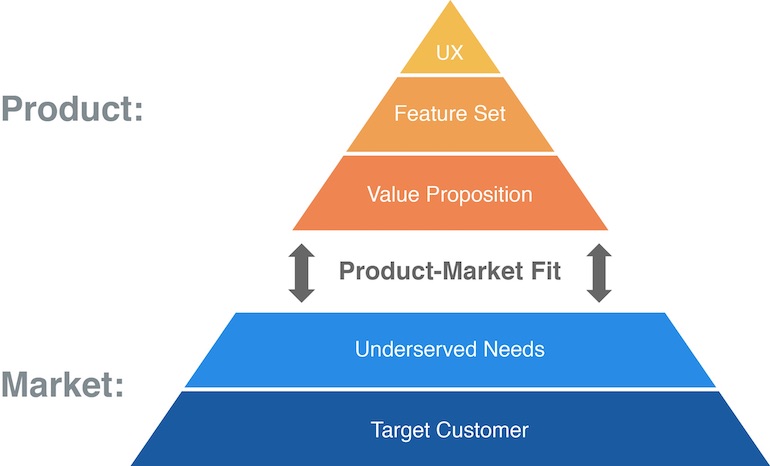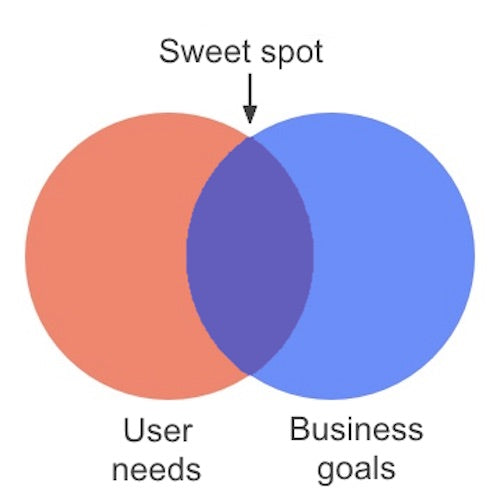Have you ever found your product team working tirelessly, yet the project seems to be at a standstill? Upon closer inspection, you might discover your team’s decision-making process is leading them astray.
This is a common scenario when a team lacks a robust product strategy to guide their design process, leading to inefficiency and misdirection.
Building a product without a product plan is like navigating without a map. While there’s a chance you’ll find your destination, there’s a high likelihood you’ll end up stranded.
This is why product strategies are important: Rather than relying solely on your intuition in product development, you (and your team) have a robust roadmap to follow, ensuring everyone pushes in the same direction—and maximizing your chances of launching a successful product.
Ready to dive into the world of product strategy? Ahead, explore what an effective product strategy is and why it’s crucial, followed by a step-by-step guide on how to develop your own effective product strategy.
What is a product strategy?
Product strategy is the backbone of product design. Your strategy tells the whole story of the product a team is building: who will use it and why they will use it. It also defines the course of action your organization must complete to develop a product, keeping everyone involved in product development on track.
A product strategy is a plan that answers the questions “what,” “why,” and “how” a company will sell its product over time.
- What products will a company create?
- Why does the company believe these are the right products for its audience?
- How will the company bring those products to market?
This overarching vision often includes market research, customer landscape analysis, competitive analysis, product positioning, and a marketing plan.
Product strategies apply to a company’s entire product portfolio and individual products. The objective is to create a unique value proposition—a compelling reason for the target audience to buy the product.
Product strategy can encompass every aspect of the product development process, including:
- Product research
- Prototyping
- Manufacturing
- Quality control
- Pricing and sales
- Marketing
- Customer service
Why is product strategy important?
Solid strategic planning turns good product ideas into success stories. It keeps new product initiatives focused and helps development teams set realistic expectations.
Here are three key advantages of committing your business to a product strategy:
1. Win a target market
No product can be all things to all people. By honing in on a specific market vision and tailoring our offering to meet particular needs and preferences, you can focus your product development on winning a specific group of potential customers.
2. Make the most of your resources
Whether you’re running a small business or a giant corporation, you’re bound to compete for resources, from supply chains to human talent. A coherent business product strategy lets you maximize your resources. That way, materials, machinery, and human capital go toward the product initiatives that show the most potential.
3. Understand your product
You learn the most about your products by trying to sell them. Insights that may not have occurred to the engineers who built the product may instead come from the marketing and sales teams offering the product to the general public.
As your team members study your product and its target users, everyone learns more about the strengths and weaknesses of your product. This knowledge will help you craft a strategic roadmap for improving, devising marketing campaigns, and appropriately pricing the item.
How to create a successful product strategy
- Identify your target audience
- Understand the problem
- Define your product vision
- Define the current state and target condition
- State product design principles
- Create a product roadmap
- Stay focused
- Define the success metrics
- Execute the strategy
1. Identify your target audience
Poor product-market fit is one of the most common reasons for startup failures. Too many companies only uncover their strategy after shipping a product to the market. As a result, they ship a product, and then see its impact. It rarely ends well. It’s easy to spot dozens of shipped products still looking for users because they were built without an understanding of the target audience. Usually, these products were built in search of problems to solve.
People use products, so it’s always a good idea to prioritize users and their needs. That’s why, before you start creating something, you need to understand your target audience’s wants and needs. The latter is especially important. Understanding your target audience not only helps you create a product that meets their needs but also fosters a sense of connection and empathy, making your product team more invested in their work.

To understand your potential users’ needs, you must make user research an integral part of the product design and development lifecycle. Conduct field studies and user interviews to understand who your users are and what they want. Use this information to define personas—archetypal models that reflect the most critical information about your target users. Well-researched personas will act as a proxy for the user.

Laura Klein, author of Lean Startup, says, product teams tend to create descriptive personas rather than predictive ones. Leveraging predictive personas makes product design much more straightforward. By analyzing them, product teams learn what their users like and dislike and the exact factors that make a person want to become a user.
2. Understand the problem
Problem definition plays a crucial role in product strategy. The product you design should help your users solve their problems. You need to identify the problem and ensure it’s worth solving—that your target audience really needs a solution for this problem and is willing to pay money for it.
It’s critical to understand the reason why you want to build a product (your business motivators) and then evaluate your product decisions in terms of the value they bring to your users (potential conversion).

3. Define your product vision
Product strategy defines a product’s journey. As with any journey, you must have a vision for where you’re headed.
Many product teams assume product vision and product strategy are the same, but in reality, they are two related but different concepts. Vision is the high-level, ultimate view of where the business is going. It’s the reason why you are making a product in the first place. A well-defined product vision becomes your organization’s north star. It helps everyone think big about what they do when working on a product.
Below are a few things to remember when defining product vision:
- Identify long-term goals. Creating a vision is easy when you have an inspiring long-term goal for what you want the product to look like in two or three years.
- Vision should be inspiring. It’s vital to get emotional buy-in from team members. That’s why your product vision should win the brain with facts and win the heart with emotions.
- You have team buy-in. It’s essential to identify your product vision and ensure everyone on your team understands the global goal. Many organizations use video format for this purpose, as conveying the message is much easier.
4. Define the current state and target condition
For many organizations, it’s possible to define two states: the current state of your product experience, and your target condition (the ultimate user experience toward which you’re aiming). Vision helps you define a target condition, or destination.
You can plan your route toward the target destination by focusing on precisely what you need to build. By setting a shared goal, you can adjust the direction of your product efforts. Investing time in analyzing, measuring, and quantifying challenges is essential before your team starts to work on your project.
5. State product design principles
Making product decisions is a risky business. No matter how hard you try, there will always be some degree of uncertainty that makes you doubt your choices.
However, you can simplify decision-making by introducing a simple yet potent tool: product design principles. Product design principles will help you define what good design means in your organization.
Well-defined principles are genuine—they reflect your product design philosophy. For example, one of the design principles of popular blogging platform Medium is “direction over choice.” The Medium design team relied on this principle to ship a product that would encourage writing. They purposely traded user interface (layout, type, and color choices) for a stripped down product so a user would begin writing sooner.
6. Create a product roadmap
A product roadmap outlines your product’s progress over time. It guides the product strategy and aligns stakeholders around the product’s development so everyone understands priorities and timelines.
While some roadmaps are date-specific, others use general time frames like quarters or seasons to indicate when features or initiatives are expected to be developed or launched. Effective roadmaps also include the required resources and milestones that mark significant progress toward your product’s launch.
Say you’re launching a new healthy soda pop. Your roadmap might look something like this:
Year 1, Q1-Q2
Goal: Develop and finalize the product formula and brand identity.
Initiatives:
- Conduct ingredient research to identify natural, low-calorie sweeteners and flavors that align with health trends like organic and non-GMO.
- Develop initial branding concepts, including logo, packaging design, and brand messaging emphasizing health benefits.
Milestones:
- Complete the initial recipe formulation and internal tasting by the end of Q1.
- Finalize packaging design and branding materials by mid-Q2.
- Begin necessary health and safety certifications by the end of Q2.
7. Stay focused
Before working on a solution to a problem, you should develop an understanding of the experience you’re aiming for. Many organizations get this step wrong. While they understand the problem, they think including more features in their product will make it valuable for their target audience. As a result, they bloat products with useless, poorly designed features and compromise their user experience. This effect is known in the software world as feature creep.
When Apple introduced the first iPhone in 2007, they built very few features but implemented them well. One of today’s must-have features, copy and paste, was missing in the first version of the iPhone. Copy and paste was omitted because it didn’t meet the team’s minimal intended experience. Instead of releasing a buggy feature, they launched the iPhone without it and added it only once it met their expectations for its experience.
A product concept called minimum loveable product suggests it’s necessary to define and implement a few essential functions very well so users will actually use them and love them.
8. Define the success metrics
It’s not enough to set a direction—it’s also essential to measure how fast you move toward the goal. Metrics help a team measure performance and know if development is on track.
If you’re looking for practical recommendations on choosing proper metrics, start with objectives and key results, or OKRs. In this model, objectives are what you want your company to achieve, and key results are how you intend to measure that objective. What numbers would move? Objectives should be inspiring, while key results should be measurable.
9. Execute the strategy
When you start building a new product, you have a threshold of knowledge. You must include any missing information to establish an ideal product strategy on Day 1. But starting with solid goals and a willingness to experiment will help you create a well-defined plan.
Start primitively and build from there. Introducing your product strategy lets you collect early feedback and iterate quickly.
The product strategy should also be revised systematically. When you learn what works and does not, revise your metrics and adjust your tactics.
Five types of product strategies
Different product strategies emphasize different elements of the development process. A successful product strategy might focus primarily on one of these categories, such as low prices (cost strategy) or reliable supply chains (turnaround strategy). Companies can simultaneously pursue multiple strategies, such as winning new customers with unbeatable prices while promoting brand loyalty with responsive customer service.
1. Cost strategy
A cost strategy attracts customers by offering the best prices in a product sector. That might mean offering the lowest prices, perhaps by charging 5% less than the next-best competitor. A cost strategy may also entail offering more significant value than other products of similar quality.
Warby Parker, for example, sells glasses. It has built a strong reputation for offering high-quality products at a fraction of the cost of traditional brick-and-mortar retailers by cutting out the middlemen and selling directly to consumers through its online store.
2. Quality strategy
You can win market share with a quality strategy by delivering a unique, reliable, well-designed product. Your product roadmap might involve passing higher prices on to customers, understanding that the steeper cost is worth the tradeoff.
For instance, consider the quality difference between a pair of handcrafted leather shoes and those made in minutes on a mass-production assembly line. The value proposition of handmade leather shoes might be that they’re more comfortable and last longer.
3. Service strategy
A service strategy gives priority to responsive customer service. You may ask your customers to compromise on price and selection in exchange for first-rate interactions with your company.
Think of American Express. Although its credit cards can be pricey and fewer retailers accept them than leading competitors, Amex maintains its customer base by offering impeccable cardholder service and perks.
4. Differentiation strategy
In a differentiation strategy, you offer products and features that no competitor offers. For example, think of a lawnmower with a proprietary mulching blade, or a cooking spatula with a patent-protected nonstick coating.
5. Focus strategy
With a focus strategy, also known as a market-oriented strategy, you gain leverage by developing product and marketing campaigns targeting a specific audience. Though your products may not appeal to the general public, they can win over the narrower markets you select.
As a reference point, think of Manscaped, which offers grooming products specifically for men. Its focus strategy cuts out more than half the population, including women and nonbinary people. However, it allows the company to explicitly cater to the grooming needs of people who identify as men and effectively communicate its USP with its target audience. For instance, the company advertises heavily on sports podcasts with primarily male audiences.
What is an example of a product strategy?
Mack Weldon was founded based on an issue the founder Brian Berger had when shopping for underwear and socks. He hated the experience of going to a department store and sifting through a never-ending sea of products. He could never find the products he liked, so he was determined to reinvent the experience of buying men’s basics.
Identifying a real problem that affects the market is a strong foundation for any product strategy. Brian started by focusing on two core issues:
- Making the shopping experience more convenient and predictable, similar to how customers appreciate the experience from brands like Starbucks.
- Building men’s basics with thoughtful features and high standards. Innovation wasn’t just for novelty; it was carefully targeted to address his target audience’s requirements and preferences.
By starting with informal conversations and moving on to structured surveys, Mack Weldon validated the broader appeal of their solutions beyond the founder’s experience.

At launch, Mack Weldon invested in a full product line and robust marketing efforts to build a strong brand. That helped build brand recognition and trust quickly. Brian understood that a brand isn’t just about products; it’s about customer perception, loyalty, and emotional engagement.
“It’s multifaceted. It’s a brand strategy. It’s a narrative. It’s a point of view. I would say we probably spent the least time on that piece,” Brian explains in a Shopify Masters interview. “We’re actually spending a lot of time on it right now. We’re coming to market with an evolved brand strategy that will position Mack Weldon as the [top menswear] brand and why it’s important for customers to associate with us from an emotional perspective.”
Product strategy FAQ
How does the product life cycle impact your product strategy?
During the introduction stage, you’re trying to get the word out about the product; during the growth stage, you’re working to maximize market share. When you’re in decline, you’ve got to update products and find new markets or phase out the old ones.
What is the difference between a product strategy and a product vision?
What are effective product strategy business models?
- Leader: You create a product that leads in the market, like Apple’s iPhone.
- Challenger: Your product challenges the market leader by offering a better experience, like the Samsung Galaxy S.
- Niche: Your product meets the specific needs of a defined market segment, like Manscaped’s entrance into the grooming products market, made specifically for men.
- Cost: You make a more cost-effective product than competitors, like Xiaomi’s affordable yet feature-packed smartphones, which compete with Apple and Samsung.





